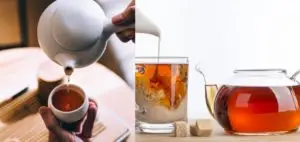In this post, I am going to talk about the importance of storing your tea to be able to enjoy it for as long as possible.
Some teas last less than others
Before I go into proper storage, I’d like to start with some general guidelines. Most green, white and yellow teas tend to have a shorter shelf life than black, oolong and pu-erh teas. That’s because more fragile teas begin to lose flavour sooner than the more oxidised teas. Arguably, the most fragile teas are Japanese green teas. Flavoured teas have a shorter shelf life than unflavoured ones because the added flavours speed up the degradation of the tea. Also, balled teas (e.g. oolongs) can be stored for longer than open-leaf teas. Finally, whole-leaf teas can last longer than broken-leaf teas.
Tea ‘enemies’
Tea deteriorates when it comes in contact with air, heat, odours and humidity. To prevent contact with these ‘enemies’, you should make sure to store the tea in an opaque container that is air-tight placed in a cool, dark and dry place away from any odours. Let’s see how each of these 4 factors can damage your tea:
- Exposure to air dries the tea leaves (i.e. it further reduces their remaining 5% moisture content) and, in turn, that will result in a flat and dull taste.
- Exposing the tea to light will turn the leaves pale and they will lose their flavour.
- Heat accelerates the oxidation of the tea which will start tasting differently.
- Odours (spices, coffee, garlic, lavender, etc.) can damage a tea very quickly because the tea absorbs odours easily.
- Humidity cannot always be avoided, especially if you live in a very humid area. If that’s your case, you can add a desiccant (e.g. silica sachet) together with the tea; its role is to keep the tea dry.
Storing tea: dos and don’ts
Now let’s see what you should do and/or avoid doing when it comes to storing your tea properly.
- Store each tea in different containers.
- Tea bought in pouches must be consumed must faster than tea bought in better air-tight containers. That’s because the tea in a pouch will lose its flavour and aroma faster.
- Buy tea in small quantities, particularly if you are unsure whether you will like it or how fast you are going to consume it. Thus, buy as much as you can consume in a relatively short period.
- Never put tea in a container used previously to store something else. Even if the container is brand new, put tea in it only after you checked that the container is odourless.
- Although a transparent glass jar may be air-tight, it still exposes the tea to light, so it’s better to avoid it. Or, place the jar in a dark cabinet or drawer.
- Keep flavoured teas separate from pure teas.
- Don’t store the tea in the fridge or freezer – the condensation will spoil it.
- For dark teas, keep them in the original wrapper. Compared to other tea types, these teas need some air exposure.
Some people argue that you should seek to buy and consume tea produced in the current year, but I don’t necessarily agree with that. That’s because this year’s harvest may be lower quality than last year’s. So, it’s better to buy a sample of the tea recently harvested before anything else.
I’m not going to suggest for how long you should keep your teas because our tastes differ and each tea is unique. In other words, you may love a 3-year old balled oolong whilst someone else may dislike it. Will you still love your favourite pu-erh tea after 5 years?! You may if you stored it properly, but that’s no guarantee. Hence, taste each tea before disposing of it.


